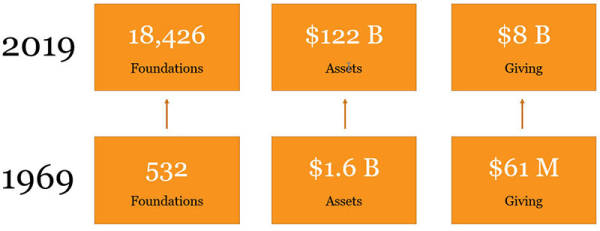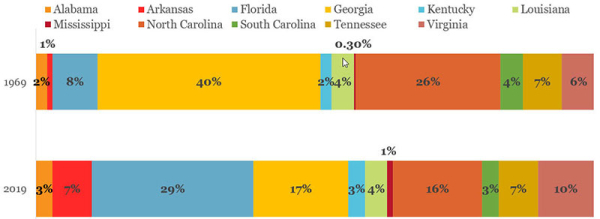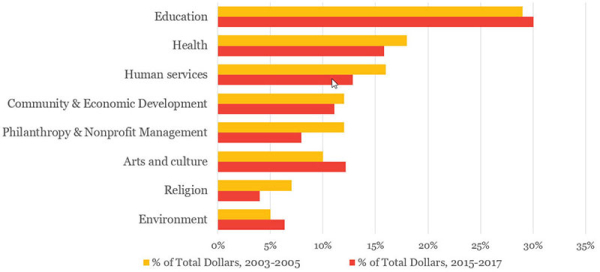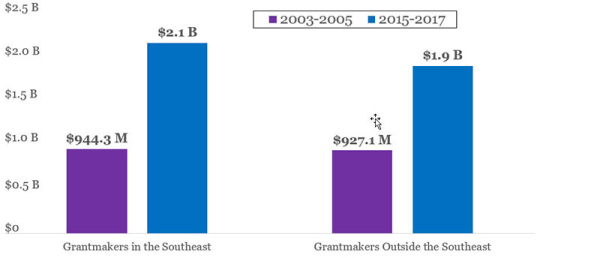50 years of Southern philanthropy
In November, I had the pleasure of speaking at SECF50, the 50th annual meeting of the Southeastern Council of Foundations. Using Candid data, I compared philanthropy in the South fifty years ago to philanthropy in the region today. Here are some of the key points I shared with the SECF50 audience.
Philanthropy has grown tenfold

To put these findings together, I had the distinct, old-fashioned pleasure of turning to one of our earliest editions of the Foundation Directory (published in 1971), an actual book, to research the state of institutional philanthropy in the South at the time of SECF’s founding. Information was a lot sketchier back then and we had to collect everything by hand, so our totals in 1969 are probably not as accurate as those we have today. Still, I believe it’s safe to say philanthropy in the South has grown tenfold after inflation.
Back in 1969, only three states in the 11-state Southeastern region had more than 75 foundations of any size (Georgia, North Carolina, and Florida), and no state had more than 107. Now, there are more than 18,000 foundations across the region, and more than half are located in just two states: Florida (6,452) and North Carolina (3,139).
Asset distribution has changed

In 1969, two-thirds of the region’s philanthropic assets were concentrated in Georgia and North Carolina (40 percent and 26 percent, respectively). Since then, assets have grown tremendously in Arkansas, Florida, and Virginia, changing the picture quite a bit. Arkansas held 1 percent of the region’s assets in 1969; it now holds 7 percent. Florida went from 8 percent to 29 percent. And Virginia increased from 6 percent to 10 percent.
Foundation types have grown

Family foundations have dominated philanthropy in the South throughout the twenty-first century. As of 2017, family foundations accounted for more than 40 percent of all foundation giving in the SECF region, about the same as in 2003, which is the date from which we’re able to track this kind of information.
At the same time, the South has also seen a great deal of growth in community foundations, with community foundation giving having grown faster than any other type of foundation giving since 2003, up more than 220 percent, while family foundation giving grew by more than 160 percent.
Philanthropy subject area has shifted

As in the rest of the country, the two subject areas that receive the greatest amount of funding are education and health. Education received 30 percent of total giving in 2017, while health received 16 percent. These figures stand somewhat in contrast to national giving patterns in the two areas. At the national level, health received 30 percent of total giving, while education received 25 percent.
Giving for arts and culture, the environment, and education have increased relative to other topics since 2003, while there have been declines in the proportion of grantmaking for health, human services, philanthropy and nonprofit management, and religion.
Sources of philanthropy have remained the same

In 2003, Foundation Center (now Candid) found that about half of all foundation support for Southern recipients — some $927 million — came from foundations located outside the region, compared to $944 million coming from Southern grantmakers. The ratio has not changed much in fifteen years. In 2017, grantmakers outside the South provided $1.9 billion in funding, whereas Southern grantmakers made $2.1 billion in grants.
(For some fascinating insights on how the types of support provided by Southern grantmakers compare with those of grantmakers outside the region, see chapter two of Philanthropy as the South’s Passing Gear: Fulfilling the Promise, on the SECF website.)
There’s more to learn

In honor of SECF’s 50th anniversary, Candid was pleased to announce the launch of a new feature on the Southern Trends Report website, “A History of Philanthropy in the South.” This timeline documents the important work of SECF since 1969 and the context in which that work took place.
What the data suggests about the future of Southern philanthropy
I’ll close by mentioning a few trends in the field that appear to be gaining some traction, or at least generating a great deal of conversation.
- General operating support — I wouldn’t describe it as a major change yet, but our data shows Southern foundations are increasingly providing more funding for general operating support, which has grown from about 16 percent of total giving to about 19 percent in recent years.
- Democracy — If you aren’t already familiar with it, I would encourage you to take a look at Foundation Funding for U.S. Democracy to see what kinds of work foundations are doing in this space. Foundations have a critical role to play here.
- Participatory grantmaking — Funders are increasingly engaging the communities they serve in the grantmaking process.
- Collaboration — This is where the promise of true impact lies. Use the laboratory for knowledge sharing and experimentation that SECF and similar associations provide to leverage your collective strength to make a difference.






